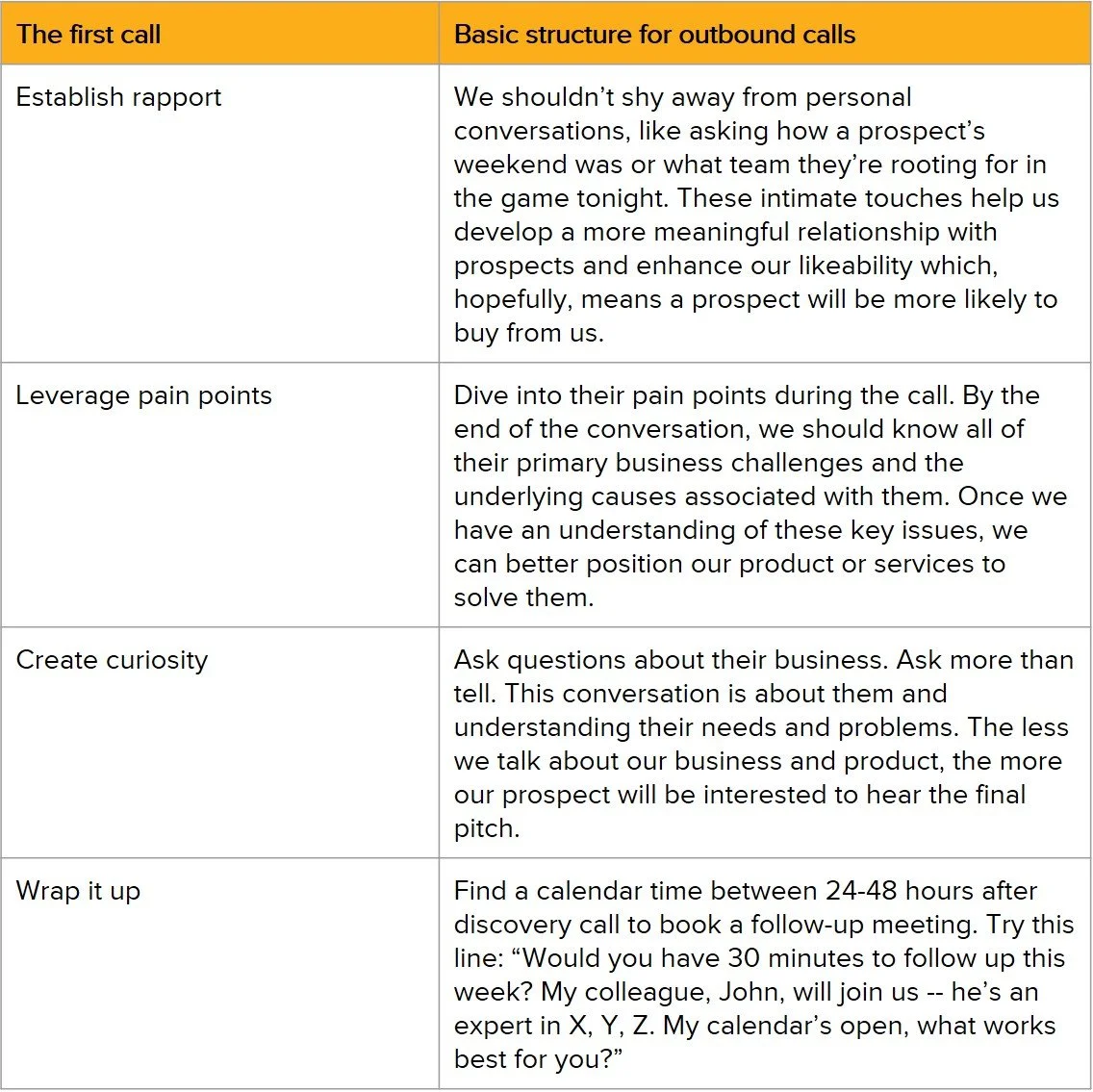A Blueprint For Strategic Sales Outreach
One aspect of sales and new business (even B2B marketing) that never changes is that the constant need to conduct outreach activities.
Making sales for an organisation entails spending time on increasing the number of outreach activity per day/week/month. Time and numbers, in this respect, often go hand-in-hand.
While sales teams are working to hit targets against that clock, they can save time and maximise the number of outreach activities by investing in the right outreach processes.
In an evolving landscape, when the recipient of the outreach is changing his or her behaviours towards sales, we’ll outline in this post the processes - in a linear blueprint - key for outreach with a view of developing prospects into leads.
Outreach and sales prospecting is the process of looking for potential customers, clients or buyers to develop sales. The end goal is to move these prospects through to qualified leads and opportunities until they convert into customers/clients.
Subscribe for marketing insights via email
The process looks something like this:
OUTREACH AND SALES TECHNIQUES
Sales and outreach processes have moved away from cold calling and spamming to a more inbound approach, where the outreach generally follows some sort of action or revolves around some sort of mutual benefit.
So rather than a message like: “Hi Gareth, I'm emailing you because I’ve worked with companies like yours previously and think you're a good fit for our services" the outreach looks more like: “Hi Gareth, I’m emailing you because I noticed you have downloaded our e-book on generating more leads."
There is usually a research process that happens before such outreach, which might be based on current behavioural website data and is shorter than a traditional approach as we already have their contact information. This gives us context about the prospect’s interests allowing us to develop more personalised outreach which has more of a chance of striking a chord. Inbound outreach as such might also consist of the following.
WARM EMAILING
Warm emails to explore a relationship with a prospect or potential lead who has already expressed familiarity with your product, service or brand.
SOCIAL SELLING
Using social media to explore a relationship with a lead, where sales and outbound teams can offer value to prospects on social media by answering their questions and introducing them to useful content.
TELEMARKETING
Although telemarketing is a daunting task, where more digital methods take centre stage, telemarketing should not go unforeseen as this traditional method of outreach can still work very well, especially for B2B organisations. CPB identifies five components of successful telemarketing to provide focus in a recent article.
THE INBOUND METHODOLOGY
Before a purchase decision, many customers rely on word-of-mouth, friends and social media for information and knowledge about the products and services in question. The State of Inbound report also notes that 49% will rely on customer references; 47% on analyst reports and recommendations; and 44% on media articles.
A prospect is already 57% of the way through the sales process before the sales team or the outreach executive starts the process. Yet, salespeople are still cold calling as if buyers have no awareness. Experienced salespeople can expect to spend 7.5 hours of cold calling to get one qualified appointment, according to a Baylor University study, 50% of sales time is wasted on unproductive prospecting.
The inbound methodology is more effective for prospecting and outreach, and is therefore recommended for more outbound and outreach efficiency.
Here is a blueprint, originally provided by HubSpot:
1. Research
2. Prioritise
3. Prepare Outreach
4. The Outreach
5. Iterate
1. RESEARCH
Researching, or gathering data on a prospect, is potentially the most important aspect of prospecting and outreaching. Here, we are qualifying the prospect to ensure that the prospect is suitable as well as improve our chances of providing value to them or their organisation
In this stage, we’re looking to accomplish a few goals:
Decide if the prospect is workable
Qualify and begin ranking prospects
Find opportunities to develop a connection through personalisation, rapport building, and trust development.
IS THE PROSPECT'S ORGANISATION A FIT?
This type of qualification is based on demographics. Does the prospect fall within our territory? Do we sell in their industry? Does it fit our buyer persona?
Diving deeper, our product or service will naturally offer higher value to a particular profile within that target market. For example, medium-sized businesses consisting of a larger team. Those customers are also more likely to upgrade to a higher tier of our product, providing more lifetime value as a customer.
HAVE YOU IDENTIFIED KEY STAKEHOLDERS?
There are two stakeholders involved on the other end of a sales process: Decision-makers and influencers.
Influencers may not have the power to buy, but they often use the product and can become internal advocates. If we get them to familiar around our offering, they can make a compelling case to decision-makers before the outreach. Decision-makers are, of course, the ones that either approve the purchase. Will anyone else be involved in this decision?
Keep a working list of influencers and decision-makers, perhaps mapped out by the organisational structure of the organisation.
DO YOU HAVE FAMILIARITY WITH THE MARKET?
We are likely to be familiar with certain types of organisations, markets or industries than others. Our outreach efforts and techniques are also likely to be more refined with markets we feel comfortable. Value-added prospects to whom we can offer more value are more likely to buy.
DO THEY HAVE AN AWARENESS OF THE OFFERING?
Our prospects will likely have varying levels of knowledge about our product or services. The more awareness, the more likely they are to see the value in our offering and become clients. If a prospect has visited our website, subscribed to our blog or newsletters or posted content about something related to our offering, they probably know a lot about our company or service.
Based on the research, we will develop a profile of our target customer and every organisation or individual on our prospect list for outreach should meet these criteria.
2. PRIORITISE
Prioritising prospects can save time and ensure sales and outbound teams are dedicating the strongest efforts to prospects that are most likely to convert. Levels of prioritisation will vary between each organisation and individual salesperson, but creating a smaller group of prospects based on their likelihood to convert should be the focus.
Let’s break down the qualifying dimensions used in our list above into percentages between 1% and 100% based on how important they are to the sales process. For example, the size of the opportunity is probably more important than timing when closing a deal, so it would receive 70% where timing would receive 5%.
Now we can assign a value between 1 and 100 to these dimensions for each prospect in our list. Once we complete this step, we can multiply each prospect’s value by the percentage weight we gave to the dimension. Add increase these dimension scores until each prospect has a total score.
3. PREPARE OUTREACH
The end goal here is to gather information on our prospects to hone our pitch and personalise the outreach. First, we must find what our prospects care about.
We can do this in a few ways:
See if the prospect blogs to define what they write about
Find their social media presence
Check the company website (about section etc.).
Once we’ve learned more about our prospect’s business and role, we need to find a reason to connect. Do we have mutual connections? Mutual interests? Has there been a trigger event such as a download? Have they recently visited our website?
To be more strategic with our preparation, we can create buyer personas and a decision map to outline our prospect's options and end-goals to better handle any objections and personalise a pitch that resonates with their primary objectives. We could also conduct a competitive analysis to determine how we can better position our company's service or product within the industry and how we can combat prospects' objections.
4. THE OUTREACH
Whether calling or emailing, the outreach should be tailored to our prospect’s particular organisation, objective or industry/sector. This can be done via automation or manually, but it is important to note that this isn't a one-size-fits-all approach. Keep these general tips in mind when contacting a prospect, whether on the phone or through email.
PERSONALISE
Reference a specific problem that the prospect is encountering with a specific solution and always look to reference the contact by name, keeping things personal where possible. However, do not over-personalise too soon as this could look and feel intrusive.
STAY RELEVANT AND TIMELY
Make sure the issue a prospect is trying to solve is still relevant to him or her and their team. There is no point building a profile on the contact with data that is dated by a number of years. Ensure that the content and your angle for outreach is timely and relevant and is worthy of a response by the prospect.
BE HUMAN
No one likes to communicate with a robot. Adding in little details like wishing someone a happy holiday weekend or by conveying how interesting their organisation’s product is are real touches that make a connection on a deeper level that is more likely to get a response.
HELP AND BUILD A RELATIONSHIP, DON’T SELL
Give value and ask for nothing. This process is not about us, it’s about them. For example, instead of scheduling a follow-up meeting, we could offer to conduct an audit on their digital media presence and get back to them with our findings in a week or so. Going into the outreach campaign with a relationship building mindset will set you up for success. For more, see our post on account-based (one-to-one) marketing.
In terms of establishing contact, we must decide between email or phone communication. Some of us will initially jump on the cold email approach while others will dive into the cold call.
The chosen tactic will vary based on what each salesperson feels most comfortable with, what the strategy is in terms of objectives, as well as what appears to be most suitable for the recipient of the outbound communication. HubSpot provides a great template for structuring outreach emails and outbound calls:
5. ITERATE
It's important to note that this process is not always going to work, and it will need constant refining. Keep notes throughout the process to assess what activities generated value is highly recommended. Those emails and calls that didn't get through to the prospect, or didn't result in anything... do they need refining? Self-reflection will help improve outbound techniques in the future.
After each contact with a prospect and following an outreach campaign, assess the following, in terms of how well we think we:
Uncovered challenges
Helped create well-defined goals
Confirmed availability of budget
Understood the decision-making process
Determined consequences of inaction
Identified potential results of success.
MAKE THE OUTREACH EASIER
Outreach campaigns are always easier for sales teams when those that are being approached are aware of you, your organisation and its products and services.
It then becomes more important than ever that you have content available - in as many places as possible - for the prospect to access to learn about you. Almost instantly, thereafter, using this strategic outbound blueprint, you have a legitimate reason to contact that prospect that is likely to get a positive response.





